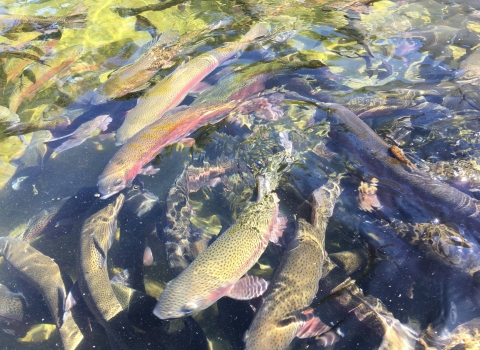The U.S. Fish and Wildlife Service announced today, the completion of the Oregon Education Project, a component of the Tenyo Maru Oil Spill Restoration Plan. The Oregon Education Project is designed to inform boaters, aircraft pilots and other coastal visitors about human disturbance impacts to nesting seabird colonies. High quality posters were produced for wide distribution and a large interpretative panel was designed and erected at 11 ports along the Oregon coast. The panels were installed this week adjacent to boat launch facilities at the Port of Brookings / Harbor, Port of Port Orford, Port of Gold Beach, Port of Bandon, Charleston Marina Complex, Port of port, Depoe Bay, Pacific City Dory Launch, Netarts Bay, Port of Garibaldi and Hammond Marina. The educational message on the poster and panel alerts the public to the sensitivity of seabirds and marine mammals, gives guidelines for operating boats near colony sites, and requests that all boats remain 500= away from the rocks and islands along the Oregon coast. The intent of the education project is to provide additional protection to nesting seabirds to mitigate for the loss of seabirds resulting from the Tenyo Maru Oil Spill. Funding for the Oregon Education Project was provided by the Tenyo Maru Oil Spill Natural Resource Trustees and is one of many restoration projects now underway. The trustees include the National Oceanic and Atmospheric Administration, U.S. Fish and Wildlife Service, Makah Indian Tribe, and the state of Washington.
The oil spill occurred on July 22, 1991, when the Japanese fishing vessel Tenyo Maru collided with the Chinese freighter Tuo Hai in heavy fog northwest of Cape Flattery on the north Washington coast. Approximately 475,000 gallons of oil and fuel spilled as the Tenyo Maru sank, subsequently thousands of seabirds were killed. Many of the seabirds were believed to have originated from Oregon seabird colonies. The U.S. Fish and Wildlife Service administers all of the rocks, reefs and islands along the Oregon coast as part of Oregon Islands and Three Arch Rocks National Wildlife Refuges. Over one million seabirds nest on these refuges. AWe are extremely pleased to be completing this project and greatly appreciate the funding provided by the Trustees@ said Roy W. Lowe, Refuge Manager for the Oregon Coast National Wildlife Refuge Complex in port, Oregon. AThe posters and panels will assist us in our continuing efforts to protect the incredible concentration of seabirds that nests along the Oregon coast,@ he said.
For additional information contact Roy W. Lowe, Project Leader, Oregon Coast National Wildlife Refuge Complex at (541) 867-4550. To request a poster contact Dawn Grafe, Refuge Operations Specialist (541) 867-4550 or email oregoncoast@fws.gov.


